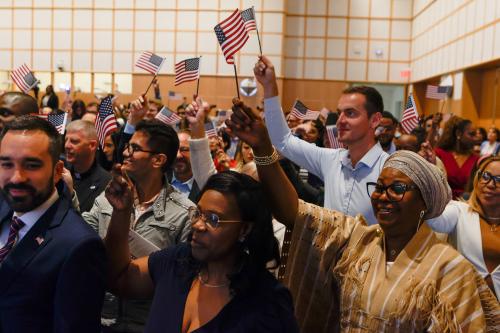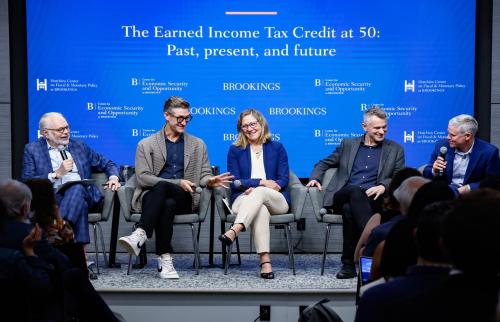As the U.S. grapples with its long history of racial exploitation and exclusion and the unacceptably large racial disparities in virtually all meaningful walks of life, a spotlight is once again beginning to focus on the plight of Black men in the U.S.
Such concern is not unprecedented. About 15 years ago, there was a brief flurry of attention paid to the high incarceration and low employment rates of Black men, and their consequences for Black families and communities.1 Indeed, some positive policy efforts ensued – particularly in the area of incarceration, where a broad consensus developed on the harmful effects of mass incarceration and the need for policy to lower it, and to help justice-involved individuals reenter society.2 Yet little positive effort was made at that time, or at any time since, to improve employment outcomes among Black men and youth; and these outcomes remain disturbingly weak.
Below I provide the latest evidence on employment rates of Black men, and review what we know about its causes. I then consider a range of policy efforts that could improve them.
Low employment among Black men
Table 1 shows employment rates in the U.S. by race and gender from recent Bureau of Labor Statistics (BLS) data that are published monthly (for ages 20 and above) in the Employment Situation Reports.
I focus on three outcomes: unemployment, labor force participation, and employment in the population. The last of these measures summarizes the effects of the other two, and remains the single best measure we have of broad employment activity.3 All three outcomes appear separately by race and gender and for both January 2020 and January 2021; the former allows us to compare racial and gender employment outcomes at the very peak of the business cycle, while the latter reflects the devastating impact of the COVID-19 pandemic and recession on these outcomes on men and women of color in the labor market.
Table 1: Employment Outcomes by Race and Gender, January 2020 and 2021 (percent)
| Jan. 2020 | Jan. 2021 | |||||
| UR | LFPR | EPOP | UR | LFPR | EPOP | |
| White Males | 2.8 | 71.8 | 69.8 | 5.5 | 69.8 | 66.0 |
| Black Males | 5.7 | 67.4 | 63.6 | 9.4 | 66.1 | 59.9 |
| Latino Males | 3.4 | 81.6 | 78.8 | 7.7 | 78.5 | 72.5 |
| White Females | 2.7 | 58.3 | 56.7 | 5.1 | 56.2 | 53.3 |
| Black Females | 5.4 | 63.5 | 60.1 | 8.5 | 59.8 | 54.7 |
| Latina Females | 4.5 | 61.1 | 58.4 | 8.8 | 57.8 | 52.7 |
Table 1 indicates the following:
- Black men have the highest unemployment rates of any race/gender group, and the lowest labor force participation and employment rates among men; and
- Black women work more than white and Latina women, and Black male participation and employment rates are just a bit higher than those of Black women (while white and Latino men work more than women in each group).
While these Black male employment outcomes are already disturbing, they obscure another important fact: the official BLS statistics don’t count many Black men with low employment, and adjusting for this fact further reduces measured Black male employment and earnings rates.
The fact that so many Black men are missing from the official data is evident when we compare the reported population sizes in the BLS data between Black men and women, where we find that the former are 17 percent below the latter.4 Male-female population gaps among white and Latino groups are not remotely as high. Differential mortality rates and immigrant arrival by gender can account for just a few percentage points of the observed gaps in population between Black males and females.
There appear to be two additional factors accounting for the lower observed civilian noninstitutional population of Black men: 1) The “undercount” of such men in such surveys; and 2) The large population of Black men incarcerated at any time. Of the 15 percentage-point gap in the Black male and female populations for ages 25-54, about 7 points are due to incarceration and 8 to the undercount among those non-incarcerated.
Including those incarcerated in population counts with no employment or labor force activity lowers the measured education and employment outcome statistics of Black men relative to Black women and all other race/gender groups. For instance, adding the currently incarcerated to the populations of Black men and women renders their employment-population ratios roughly equal – at about 59 percent and 56 percent in January 2020 and 2021 respectively. And, if the undercounted (but not currently incarcerated) population of Black men has worse employment outcomes than those counted – which appears likely to be the case – then the employment of Black men falls below that of Black women.5 Indeed, Black male employment is lower than that of Black females despite the fact that women also provide the vast majority of the child custody and care in this population.6Bayer and Charles (2017) present estimates of employment gaps between white and Black men at various points in time, using data from the Census or American Community Surveys (ACS) which include the incarcerated but not those undercounted. Table 2 presents their estimates of the percentages of each group (in the ACS) not working in 2013-14 – both at the time of the survey and over the entire previous year – and also presents the percentages not working who are institutionalized (almost all incarcerated) or out of the labor force (not incarcerated).
Table 2: Men Without Work in 2013-14, Ages 25-54, Among Whites and Blacks (percent)
| Whites | Blacks | |
| Not Working Now | 17 | 35 |
| Not Working Past Year | 12 | 27 |
| Institutionalized | 2 | 8 |
| Out of the Labor Force | 11 | 17 |
The data indicate extremely high rates of prime age Black men without work – over a third are not working at the time of the survey and over a quarter over the entire past year. Those incarcerated account for a third of those out of the labor force. Adjusting for those undercounted would likely raise the racial gaps we observe.
Also, Bayer and Charles show that adjusting annual earnings estimates to include white and Black men with zero earnings reduces the observed relative education and earnings of Black men and eliminates any observed progress of in their earnings (relative to white men) since 1950. Indeed, these estimates show that the median annual earnings of Black men are only about half of those of white men – at just over $20,000 and 40,000 respectively.
Finally, Chetty et al. (2020) show that Black men experience less upward and more downward mobility over time, relative to their parents, than do any other race/gender group in the U.S., a finding that is driven by their weak employment and earnings outcomes relative to these other groups.
What explains low employment among Black men?
For decades, a research literature by social scientist has documented earnings and employment gaps between Black and white Americans, and between Black men and other men more specifically, and analyzed their causes.
In my view, the major causes of lower employment and earnings among Black men than other groups can be summarized as follows:
- Proximate causes: Lower education, skills and work experience
- Ultimate causes: Discrimination and social/spatial isolation
- Mediating factors: Lower marriage/child custody rates and worse health
- Reinforcing long-run factors: Crime/incarceration and child support
While one could argue (and I would agree) that all of these factors are the products of a long history and ongoing reality of systemic racism, focusing on these specific factors is important if we want to generate a practical policy agenda to mitigate these problems. And, though I lump together the predictors of earnings gaps with those of employment gaps between Black men and other groups, some of these factors affect employment and earnings together whereas others create barriers or disincentives to employment more specifically.7
- Proximate causes: Education, skills, and work experience
It is widely known that education, skills, and work experience are major determinants of employment and earnings in the U.S. Indeed, gaps in “human capital” across race and class groups has increasingly driven the rising inequality in earnings that we observe over the past several decades.
It is also well known that Black Americans lag behind white Americans (and Asian Americans) in educational attainment, and that men generally lag behind women. For instance, data on bachelor’s degree (BA/BS) attainment by race and gender in 2019 show that .24 and .28 have such degrees among Black males and females, ages 25 and over; comparable percentages among whites are .36 and .37.8 If adjusted for undercounting and incarceration among Black men, the gaps between them and the other groups would be higher.
The lower educational attainment of Black men, relative to both white men and Black women, no doubt reduces their earnings levels and employment relative to both groups. Indeed, Black men have relatively lower educational attainment than Black women and white men and women at other levels of education as well (such as high school completion and associate degree attainment).
Of course, there have been growing gaps in labor force activity between college and non-college men of all races, as the labor force activity of high-school educated men has been declining for decades. Even so, employment rates among Black men with high school or less education have been well below and declined more rapidly than those of similar white and Latino men.9 The disappearance of well-paying jobs in durable manufacturing and other industries, and the decline of unions, have hurt the earnings and employment of Black men more than white and Latino men; and the stagnation of the federal minimum wage has likely hurt as well.
Observed gaps between Black men, Black women, and white men and women can also be found on other important dimensions of skill. For instance, the “achievement gap” between white and Black people (and also between men and women), as measured by scores on standardized tests, has been well-documented. Some evidence suggests the gap narrowed modestly in the 1980s and 1990s but has remained fairly stable since then.10 Test scores reflect cognitive skills that help determine not only higher education attainment, but labor market rewards as well.
Though they have been somewhat less documented and explored, a range of non-cognitive or socio-emotional skills – such as external and internal direction of aggression, motivation, and social skills – contribute importantly to both educational attainment and earnings as well. Here again, the evidence suggests that the Black population lags behind the white population along a number of dimensions.
Finally, consistent and accumulating employment gaps between white and Black Americans, which emerge as soon as they enter the labor market, generate less work experience for Black workers. The extent to which lower work experience “scars” workers, reducing their wages and/or employment over time, has been the subject of some debate among economists, and recent evidence suggests that some scarring occurs.11
Still, Neal and Johnson show that, when statistically controlling for education, test scores, and work experience, observed earnings gaps between Black and white workers largely (though not completely) disappear. And while the exact interpretations of this evidence can be debated, the empirical fact has largely been accepted by economists and other social scientists.
At the same time, the observed racial gaps in education, cognitive and noncognitive skills, and work experience raise important questions about what drives these gaps in the first place.
- Ultimate causes: Discrimination and social/spatial isolation
There is abundant evidence that Black Americans and especially Black men face systematic discrimination in the labor market and in other walks of life, such as schooling. This discrimination limits their ability to accumulate skills and education credentials as well as work experience.
For instance, Holzer (1996) provides survey evidence that Black men receive fewer job offers than any other race/gender group as job applicants, especially in the lower-wage service sector. Several audit studies (which send out applicants of mixed race or gender with identical resumes to apply for jobs) provide evidence that Black applicants receive fewer callbacks from employers than white applicants. Devah Pager (2003) also shows that Black men without criminal records receive such callbacks at only approximately the same rate as white men with such records. And Charles and Guryan (2008) show that Black male earnings are relatively lower in states where whites express racial prejudice (as measured in the General Social Survey), and that such prejudice can account for a fourth of the Black-white wage gap among men.
While rigorous evidence of discrimination in the treatment of Black boys (and girls) in school is much more limited (as audit studies within schools are quite difficult to implement), we find large disparities by race in disciplinary actions such as suspensions from school and in grade retention. And some strongly suggestive evidence appears to link such disparities to geographic areas where racial discrimination appears more prevalent.
In addition, racial segregation and social isolation contribute to weak education and employment outcomes as well. Metropolitan areas in the U.S. remain quite racially segregated, especially between Black and white households; a combination of housing market discrimination, exclusionary zoning in higher-income/white neighborhoods, and “white flight” when minorities enter these neighborhoods perpetuates the segregation over time. And, since enrollments in public K-12 schools depend primarily on where people live, segregated residential neighborhoods generate segregated schools, that limit student achievement and employment outcomes over time.
Social networks among Black Americans, and especially those residing in segregated neighborhoods, tend to be weak as well. We have long known that such networks play important roles in helping workers find jobs; but new evidence is now appearing that such networks impede the ability of Black Americans, and especially men, to have access to well-paying jobs in many regions of the U.S. And given the absence of Black men from the labor market in many such neighborhoods, as we noted earlier, the networks available to younger Black men now entering the labor market are especially too weak to help those without college degrees find and keep well-paying jobs.
3) Mediating factors: Marriage and health
Declining employment among less-educated men in the U.S., and especially Black men, has been correlated with a decline in marriage rates. It is hard to determine exactly to what extent this relationship is causal; and, if it is, in which direction the causation works. What seems most likely is that causal effects work both ways – on the one hand, a lack of effective employment opportunities renders many (Black) men as less “marriageable”; on the other hand, lower marriage rates reduce the incentives of men to work to support their families.
Weak health also impedes labor force activity, especially among less-educated men. The health of less-educated white men has deteriorated the most in recent years, due to substance abuse and obesity, and racial gaps in such well-being have narrowed; but most evidence suggests that morbidity and mortality among Black men continues to be higher than among comparably educated white men. Self-reported disability also appears to be very high among Black men and women out of the labor force in Detroit and other major cities.
4) Reinforcing long-run factors: Crime/incarceration and child support
The enormous racial disparity in incarceration rates in the U.S. is widely known. At its peak, it was estimated that about one-third of all Black men appeared likely to spend some time in their lives being incarcerated, while among high school dropouts the rate was an appalling two-thirds.
The higher incarceration rate among Black Americans, in turn, is likely driven by three factors:
- Higher participation in crime, including violent crime;
- Harsher criminal sentences imposed on the crimes that Black men are relatively more likely to commit (such as possession and sales of crack cocaine relative to powder); and
- Discriminatory policing and more frequent conviction in the criminal justice system
The fact that Black men have participated more frequently in crime, especially during the 1970s and 1980s, was at least partly driven by their perception that the relative rewards to legal work were declining among the less-educated, while the rewards to crime (especially drug sales) were growing. But drug sales also led to the “crack wars” of the 1980s and beyond, which imposed enormous costs on Black men in terms of employment loss, incarceration and death.
While such violent crime has declined greatly since the mid-1990s, leading to great improvements in the quality of life in residents of low-income Black neighborhoods, such activity remains considerably higher among Black than white men, according to several sources of data.12 And young Black men in such neighborhoods remain more targeted by police, and more subject to the use of force as well as incarceration. Indeed, incarceration has risen over much of the past 2-3 decades while crime has declined – with the former perhaps contributing to the latter – though the incarceration rate has also been declining over the past several years.
But there now seems little doubt that incarceration reduces subsequent employment among ex-offenders, especially Black men. At a minimum, such men fail to accumulate meaningful work experience while they are incarcerated. But, in addition, their experiences lead employers to avoid hiring them and for the men themselves to become permanently disconnected from employment networks.
In addition, declining marriage rates between Black men and women, along with rising percentages of children being born to unwed parents, have resulted in the fact that over 60 percent of all Black children are born to single parents. In response, enforcement of child support orders on non-custodial Black men by the U.S. child support system has grown more rigorous. While such enforcement has generated some positive outcomes for Black single mothers and their children, when fathers cannot or do not pay they go into “arrears,” or debt, on their payments; and, since the deduction of child support payments from their formal earnings grow very large when this happen, it apparently drives some of these non-custodial fathers out of the formal labor market – in much the same way that high tax rates might do so. And, despite some reforms in the child support system during the Obama years that were designed to ease this pressure on poor men, their incentives to work when in arrears remain limited.
Conclusion: What should we do to raise employment among Black men?
Low employment rates among Black men have no single cause, but instead reflect a range of interacting and reinforcing demographic, social, and economic factors, plus adverse policy choices over time. These include low levels of educational attainment, skills, and work experience; discrimination in employment and likely in education as well as geographic and social isolation; low marriage and health levels; and participation in the criminal justice and child support systems.
Accordingly, raising the employment rates of Black men will require sustained policy efforts along a number of these dimensions to improve outcomes. Among the efforts that would most likely improve their employment rates would be the following:
- Desegregating schools and neighborhoods as much as possible;
- Investing in pre-K and K-12 policies to raise cognitive and socio-emotional skills among children, especially those in predominantly Black neighborhoods;
- Providing early work experience for youth, including summer youth employment;
- Raising the federal minimum wage;
- Reducing incarceration rates while expanding cost-effective “reentry” programs;
- Expanding services to raise employment and child support payments of non-custodial fathers while reducing the disincentives to work created by “arrears”; and
- Subsidizing jobs for the many long-term unemployed and out of the labor force for whom it would be very challenging to find and keep private sector jobs on their own.
Though we do not have abundant evidence of cost-effective policies in each area, we should implement and fund them where we do have such evidence, and experiment and evaluate where we don’t.
But the existence of large racial disparities between Black men and other groups should not be tolerated or accepted as inevitable. Policy choices are available that can enable us to make progress on this issue, and it is imperative that we explore and implement them.
-
Footnotes
- See Mincy (2006) and Holzer et al. (2005).
- Indeed, many conservatives joined their progressive colleagues in decrying mass incarceration, due to its negative impacts both on employment and liberty. Such widespread consensus ultimately resulted in the passage of the Second Chance Act in 2018.
- Algebraically, EPOPR=(1-UR)*LFPR, where EPOPR, UR and LFPR respectively denote the employment-to-population ratios, unemployment rates and labor force participation rates of any group.
- The population size of Black women (ages 20 and above) in the BLS data is 16.95 million, and that of Black men is just 14.14 million.
- See Pettit (2012). In a recent paper, Kahn-Lang (2018) calculates that the “missing” Black men likely lead our estimates of their education, labor force participation, and earnings to be overestimated. Her estimates do not suggest that estimated employment rates for Black men are overstated, though she infers this from the fact that Black men who are ultimately incarcerated have roughly equal earnings to those at risk but not ultimately incarcerated. But it is quite likely that estimated earnings diverge for these two groups after one group experiences incarceration.
- Higher college enrollments should also reduce employment among Black women relative to Black men, at least in the short term. In 2019, the college enrollment rates of Black men and women in ages 18-24 were 33 and 41 percent respectively. Though enrollments now also include many people in ages 25 and above, estimates suggest that the gaps between males and females in that population are also sizable (Holzer and Baum, 2017). Of course, higher college enrollments among women lead to higher college completion, which raises their employment over the longer term.
- Economists believe that anything that lowers worker wages, all else equal, reduces their incentives to work; the extent to which this is true depends on what we call labor supply elasticities. But other factors, such as criminal records or poor health, specifically create barriers to work at any wage.
- Attainment rises for all in the 25-29 age group relative to 25 and above, except among white males. Latino males and females have the lowest attainment of any racial groups. This no doubt reflects recent immigrants from Latin America, who tend to have low education levels. Somewhat interestingly, Latino males have the lowest education levels but the highest labor force activity of any group, likely reflecting the high propensity of Latino male immigrants to work, even in low-wage jobs.
- As more people enroll in college over time, the employment rate of those not enrolled will deteriorate, as they are more concentrated at the bottom end of the skill distribution. But, since more white men than Black men have enrolled in college, this negative effect of the changing composition of the population should be greater for the former than the latter, though employment among the latter has declined more.
- See the estimates of achievement gaps by race and ethnicity generated by the Stanford Center on Education Policy: https://cepa.stanford.edu/educational-opportunity-monitoring-project/achievement-gaps/race/.
- For instance, see Schmiller and Umkehrer (2018).
- According to the Uniform Crime Reporting data from the FBI, the homicide rate among Black Americans is six times as high as that among whites, though questions exist about the accuracy of these data. And, according to the National Crime Victimization Survey, the rate of non-homicide violent crimes among Blacks is over twice as high as among whites.
The Brookings Institution is committed to quality, independence, and impact.
We are supported by a diverse array of funders. In line with our values and policies, each Brookings publication represents the sole views of its author(s).






